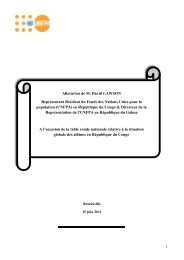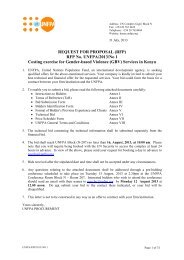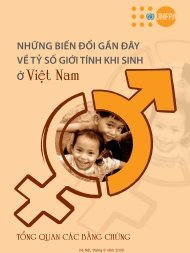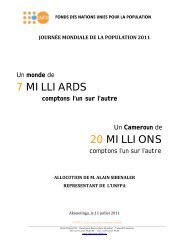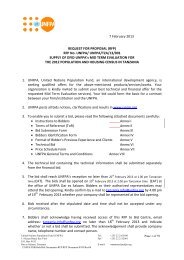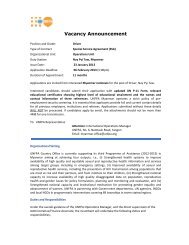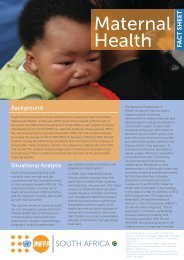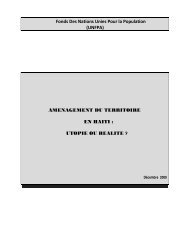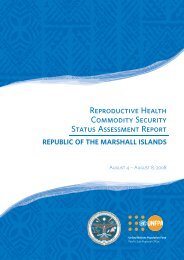A reproductive health needs assessment in Myanmar
A reproductive health needs assessment in Myanmar
A reproductive health needs assessment in Myanmar
You also want an ePaper? Increase the reach of your titles
YUMPU automatically turns print PDFs into web optimized ePapers that Google loves.
A Reproductive Health Needs Assessment <strong>in</strong> <strong>Myanmar</strong><br />
that he encourages them to supply these young people with contraception, but f<strong>in</strong>ds it<br />
difficult to account for this on his official report<strong>in</strong>g forms.<br />
Despite the fact that many providers believe that all women want to get pregnant immediately<br />
after marriage, there are <strong>in</strong>dications that many women who marry young do wish to delay<br />
their first birth and do have need of contraceptive services. Many community members<br />
<strong>in</strong>terviewed dur<strong>in</strong>g the <strong>assessment</strong> made this po<strong>in</strong>t to the <strong>assessment</strong> team. It appears<br />
however, that contraceptive use is not generally started until after the marriage itself, and the<br />
first sexual exposure. The team spoke with one man whose wife had taken a three-month<br />
<strong>in</strong>jectable on the day after their wedd<strong>in</strong>g so that she wouldn’t get pregnant too soon.<br />
Tachileik was an exception to this, where as noted previously the issue of pre-marital sex is<br />
more openly discussed and accepted than <strong>in</strong> other areas. The contraceptive utilisation rate<br />
among young woman, both married and unmarried, seems to be quite high. Most of these<br />
contraceptives were purchased across the border <strong>in</strong> Thailand where it was reported that fewer<br />
questions were asked, anonymity is ma<strong>in</strong>ta<strong>in</strong>ed, and the quality of the products is perceived<br />
to be higher. This is true of all <strong>reproductive</strong> <strong>health</strong> services despite the availability of formal<br />
<strong>health</strong> services at all levels on the <strong>Myanmar</strong> side of the border. The team noted that, s<strong>in</strong>ce<br />
they were unable to visit any of the more remote areas of Tachileik township, this may not be<br />
the case throughout the township.<br />
Midwives appear to be judgmental when see<strong>in</strong>g unmarried adolescents with <strong>reproductive</strong><br />
<strong>health</strong> problems. They often have pre-formed ideas about the appropriate actions such<br />
<strong>in</strong>dividuals should take. This partly <strong>in</strong>fluences young people’s decisions to go to private<br />
providers or not to seek formal <strong>health</strong> care at all.<br />
INFORMATION MATERIAL AND SOURCES<br />
As noted above, very few <strong>in</strong>formation materials are available which address the <strong>reproductive</strong><br />
<strong>health</strong> concerns of young people specifically, and adolescents tend to have very limited<br />
access to formal channels of <strong>health</strong> education. Both the youth themselves, as well as parents,<br />
teachers and providers, report be<strong>in</strong>g reluctant to <strong>in</strong>itiate discussions that <strong>in</strong>volve sensitive<br />
issues related to sexual behaviour. If provided with appropriate support, however, a number<br />
of different groups of people were felt to be able to provide accurate <strong>in</strong>formation on<br />
<strong>reproductive</strong> <strong>health</strong> to the young population, <strong>in</strong>clud<strong>in</strong>g teachers, parents, and <strong>health</strong><br />
personnel.<br />
Dur<strong>in</strong>g the <strong>assessment</strong>, MCWA members who were work<strong>in</strong>g closely with the community<br />
consistently mentioned that mothers were the best source of <strong>in</strong>formation for their daughters.<br />
The major concern expressed with this strategy was the limited <strong>health</strong> literacy of many<br />
mothers themselves. There was no similar suggestion that fathers would be a good source of<br />
<strong>in</strong>formation for their sons. Most community members, <strong>in</strong>clud<strong>in</strong>g the adolescents, expla<strong>in</strong>ed<br />
that discussions of sexual and <strong>reproductive</strong> matters did not occur between people of different<br />
sexes <strong>in</strong> a family.<br />
The need for more <strong>health</strong> education <strong>in</strong> schools for adolescents on <strong>reproductive</strong> <strong>health</strong> issues<br />
was expressed strongly by providers, parents and young people themselves, although the<br />
young people thought that there may be objections from teachers and parents. They thought<br />
that before any <strong>reproductive</strong> <strong>health</strong> education could be successfully provided <strong>in</strong> schools,<br />
advocacy activities would need to be conducted with both parents and teachers to make them<br />
54




